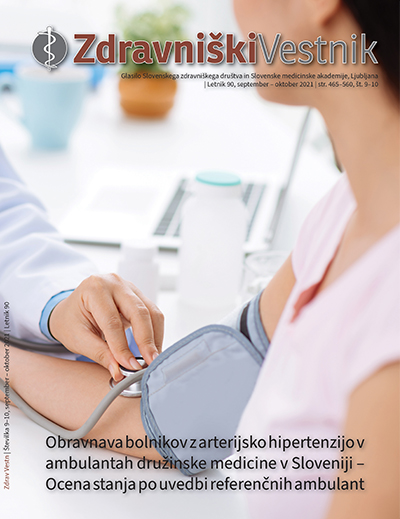Management of newborns with anorectal malformation
DOI:
https://doi.org/10.6016/ZdravVestn.3102Keywords:
anorectal malformations, radiology diagnostics, new-born surgery, posterior sagittal anorectoplastyAbstract
This review article presents the management protocol of new-borns with anorectal malformation in Slovenia. The clinical presentation, diagnostics and surgical management are described. Optimal functional result is possible when the condition is recognised early and managed according to the described protocol. We have searched the literature for guidelines on anorectal malformation treatment, and present some data of a single centre (University Medical Centre Ljubljana, Slovenia) retrospective analysis of anorectal malformation management. Our achievements are the result of a well-coordinated multidisciplinary approach and adherence to the treatment protocol.
Downloads
References
1. Murphy F, Puri P, Hutson JM, Holschneider AM. Incidence and Frequency of Different Types, and Classification of Anorectal Malformations. In: Holschneider AM, Hutson JM. Anorectal Malformations in Children. Berlin: Springer; 2006. pp. 163-84.
2. Kluth D, van der Putte SC, Penington E, Kluth D, Fiegel H. Embryology of anorectal malformations. Semin Pediatr Surg. 2010;19(3):201-8.
DOI: 10.1053/j.sempedsurg.2010.03.005
PMID: 20610193
3. Wang C, Li L, Cheng W. Anorectal malformation: the etiological factors. Pediatr Surg Int. 2015;31(9):795-804.
DOI: 10.1007/s00383-015-3685-0
PMID: 25899933
4. Stephens FD, Durham-Smith E. Classification, identification, and assessment of surgical treatment of anorectal anomalies. Pediatr Surg Int. 1986;1(4):200-5.
DOI: 10.1007/BF00177146
5. Holschneider A, Hutson J, Peña A. Preliminary report of the International Conference for the Developments of Standards for Treatment of Anorectal Malformations. J Pediatr Surg. 2005;40(10):1521-6.
DOI: 10.1016/j.jpedsurg.2005.08.002
PMID: 16226976
6. Stoll C, Alembik Y, Dott B, Roth MP. Associated malformations in patients with anorectal anomalies. Eur J Med Genet. 2007;50(4):281-90.
DOI: 10.1016/j.ejmg.2007.04.002
PMID: 17572165
7. Endo M, Hayashi A, Ishihara M, Maie M, Nagasaki A, Nishi T, et al.; Steering Committee of Japanese Study Group of Anorectal Anomalies. Analysis of 1,992 patients with anorectal malformations over the past two decades in Japan. J Pediatr Surg. 1999;34(3):435-41.
DOI: 10.1016/S0022-3468(99)90494-3
PMID: 10211649
8. Salomon BD, Baker LA, Bear KA, Cunningham BK, Giampietro PF, Hadigen C, et al. An approach to the identification of anomalies and etiologies in neonates with identified or suspected VACTERL (vertebral defects, anal atresia, tracheo-esophageal fistula with esophageal atresia, cardiac defects, renal and limb anomalies) association. J Pediatr. 2014;164(3):451-7.
DOI: 10.1016/j.jpeds.2013.10.086
PMID: 24332453
9. Watanabe Y, Ando H, Seo T, Kaneko K, Katsuno S, Shinohara T, et al. Three-dimensional image reconstruction of an anorectal malformation with multidetector-row helical computed tomography technology. Pediatr Surg Int. 2003;19(3):167-71.
DOI: 10.1007/s00383-002-0911-3
PMID: 12768311
10. United Nations Scientific Committee on the Effects of Atomic RadiationSources and Effects of Ionizing Radiation, UNSCEAR 2008 Report to the General Assembly. Annex B: Exposures of the Public and Workers from Various Sources of Radiation. ;Vol. 1. New York: United Nations; 2010.
11. Han TI, Kim IO, Kim WS. Imperforate anus: US determination of the type with infracoccygeal approach. Radiology. 2003;228(1):226-9.
DOI: 10.1148/radiol.2281011900
PMID: 12738873
12. Samuk I, Bischoff A, Freud E, Peña A. Tethered cord in children with anorectal malformations with emphasis on rectobladder neck fistula. Pediatr Surg Int. 2019;35(2):221-6.
DOI: 10.1007/s00383-018-4399-x
PMID: 30413919
13. Lee AG, Grant NG. Grainger and Allison’s Diagnostic Radiology Essentials. 2nd ed. Amsterdam: Elsevier; 2019.
14. Alamo L, Meyrat BJ, Meuwly JY, Meuli RA, Gudinchet F. Anorectal Malformations: Finding the Pathway out of the Labyrinth. Radiographics. 2013;33(2):491-512.
DOI: 10.1148/rg.332125046
PMID: 23479709
15. Chow JS, Paltiel HJ, Padua HM, McNamara E, Dickie BH. Contrast-Enhanced Colosonography for the Evaluation of Children With an Imperforate Anus. J Ultrasound Med. 2019;38(10):2777-83.
DOI: 10.1002/jum.14948
PMID: 30693972
16. Chan KW, Lee KH, Wong HY, Tsui SY, Wong YS, Pang KY, et al. Outcome of patients after single-stage repair of perineal fistula without colostomy according to the Krickenbeck classification. J Pediatr Surg. 2014;49(8):1237-41.
DOI: 10.1016/j.jpedsurg.2013.11.054
PMID: 25092083
17. Toft L, Salo M, Arnbjornsson E, Strenstrom P. Wound dehiscence after posterior sagittal anorectoplasty in children with anorectal malformations. BioMed Res Int. 2018;1:1-6.
DOI: 10.1155/2018/2930783
18. Levitt MA, Peña A. Anorectal malformations. Orphanet J Rare Dis. 2007;2(33):33.
DOI: 10.1186/1750-1172-2-33
PMID: 17651510
19. Peña A, Devries PA. Posterior sagittal anorectoplasty: important technical considerations and new applications. J Pediatr Surg. 1982;17(6):796-811.
DOI: 10.1016/S0022-3468(82)80448-X
PMID: 6761417
Downloads
Published
Issue
Section
License

The Author transfers to the Publisher (Slovenian Medical Association) all economic copyrights following form Article 22 of the Slovene Copyright and Related Rights Act (ZASP), including the right of reproduction, the right of distribution, the rental right, the right of public performance, the right of public transmission, the right of public communication by means of phonograms and videograms, the right of public presentation, the right of broadcasting, the right of rebroadcasting, the right of secondary broadcasting, the right of communication to the public, the right of transformation, the right of audiovisual adaptation and all other rights of the author according to ZASP.
The aforementioned rights are transferred non-exclusively, for an unlimited number of editions, for the term of the statutory
The Author can make use of his work himself or transfer subjective rights to others only after 3 months from date of first publishing in the journal Zdravniški vestnik/Slovenian Medical Journal.
The Publisher (Slovenian Medical Association) has the right to transfer the rights of acquired parties without explicit consent of the Author.
The Author consents that the Article be published under the Creative Commons BY-NC 4.0 (attribution-non-commercial) or comparable licence.



